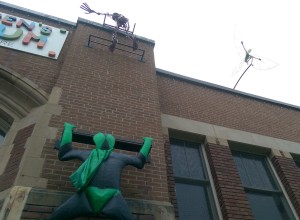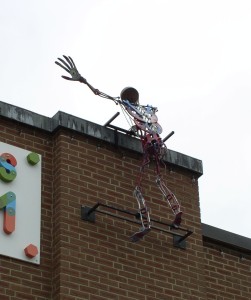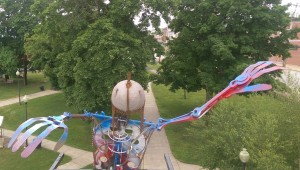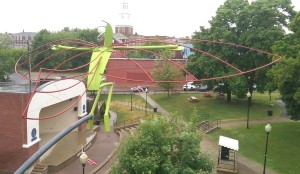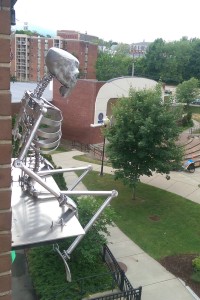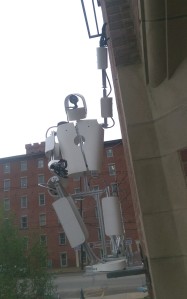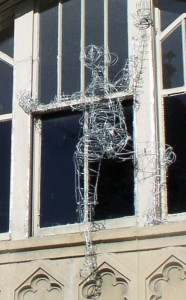The Museum Blog
Category: Exhibits
Reflecting on my Summer Internship at CMNH
It's time to start thinking about summer internships. Read on to hear what this former intern had to say about her internship at the Children's Museum of New Hampshire.
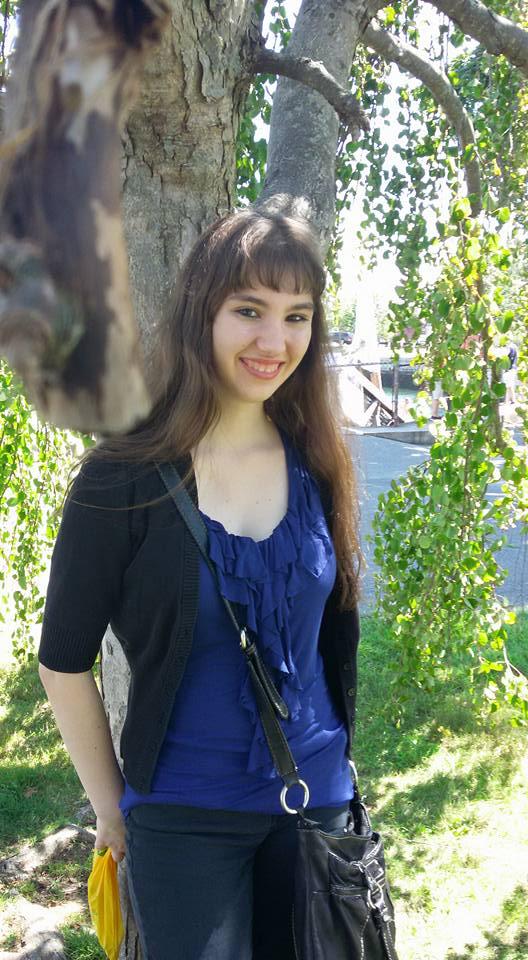 By: Amanda Girard
By: Amanda Girard
I remember visiting the Children’s Museum in Portsmouth when I was younger. I remember playing in the Yellow Submarine and the fishing boat and creating works of art in what is now known as the Muse Studio. I had a lot of really great memories there.
That younger version of myself could’ve never imagined that one day I would return here as an intern and spend a summer here. Yet, here I am on both the last day of my internship and my 20th birthday!
I have really enjoyed my time at CMNH and I have successfully completed so many projects that I am proud of. I am going to college for a degree in Professional Writing with a minor in Marketing and I really have combined the two in this internship with the Marketing department.
I had a few projects that spanned the length of my entire internship (From Mid-May to the beginning of August). I wrote biographies for all of the over 50 Makers who will be part of the 2015Dover Mini Maker Faire. I had never even heard of Maker Faire until I started to work here and I think it’s just an amazing idea that will only grow as time goes on. As I was writing the biographies, I would always get excited and wound up wishing that I could be around when it happens, as I will be studying abroad in Dublin at the time. Nevertheless, I am proud that I could be a part of getting people excited for Maker Faire this year!
I also worked for a majority of the summer interviewing office staff, museum educators, and volunteers for “Meet the Staff” blog posts for this blog. I enjoyed this project a lot because I got to meet many of the wonderful staff at the Children’s Museum. Everyone here is so kind and friendly and just a lot of fun! I got to experience what it is like to work in an office setting and I saw first-hand how a group of people with many different talents can come together for a common goal: in this case, to provide an amazing experience for children and their families.
Speaking of children and their families, I got to read what they thought of CMNH firsthand with another one of my ongoing projects. One of the first things that I did in the mornings when I arrived for work was check to see if there were any new visitor surveys. I gathered almost 40 surveys over the course of the summer and compiled them. Some outcomes of this were a tally of visitor’s favorite exhibits (with the Yellow Submarine at the top of the list!) and two blog posts about what the Museum offers to older kids and how our exhibits help toddlers learn through repetition.
Other things that I accomplished during my time here include writing tweets and Facebook posts (some things that I had never really tried before!), covering events like Group Visits and the Teddy Bear Clinic and Picnic, crafting emails, tracking visitor zip codes and writing press releases for Museum events and classes.
So what have I learned from doing all of this? Well, I’ve learned another way that I can use my writing in the future and I’ve learned the basics of marketing and social media outreach. I’ve learned about the amount of research that goes into marketing a company and a brand and I’ve learned that I actually really love doing that research! I have also learned what it’s like to work in an office and how to coordinate and work together to accomplish a goal.
But the biggest thing I think I’ve learned, that I already sort of knew, was that I really like working with children and seeing their reactions of joy and excitement when they see the finished product of something we have all worked so hard to create for them. I think that that is an interest that I would really like to pursue further and I’m not sure where that will lead me. But interning at CMNH this summer solidified that the interest is there and who knows where that will lead me in the future!
I am extremely thankful for the opportunity and experience that I have had at the Children’s Museum of New Hampshire this summer and for every amazing person that I have gotten the chance to meet in the process!
A MOSAIC of Cultures to be Explored
Gallery 6, the space reserved for art inside the Children’s Museum of New Hampshire, will have a new exhibition opening on March 5 and featuring art from many different cultures. MOSAIC: Exploring Our Multicultural Neighborhood will be paired with a special celebration of cultural exploration on Saturday, March 12, where guests can taste North African cooking, enjoy traditional Bhutan dancing and music, try their hand at Chinese brush painting and take part in a community art project.
The art on view in MOSAIC will include photographs of immigrants and refugees living in New Hampshire taken by Becky Field from her book Different Roots, Common Dreams, which came out in the Fall of 2015. Photographer David Hiley, who traveled to Haiti with a group of Seacoast, NH medical professional volunteers in coordination with the Haitian Health Foundation, will present his series of Haitian “selfies” of children and parents. “My eye was drawn to the tension I saw between wrenching poverty and the vibrancy and dignity of these children,” shared David. “Allowing the children to take selfies captured the curiosity and joy common to children everywhere.” Also on view will be photographs of children from China taken by retired pediatrician Skip Small and a glimpse into the life of a child from Japan curated by Sayaka and Seth Blewitt. Also on view will be selected dolls from the Museum’s collection of dolls from around the world.
The special celebration of MOSAIC promises to be just as diverse as the cultures represented in the art itself. The event will be from 11am-2pm on Saturday, March 12 at the Children’s Museum of New Hampshire in Dover. Guests who come in traditional cultural costumes (super heroes and princess costumes do not apply) will receive half-off their individual admission. From 10:45am-Noon European classically trained chef Patrice Gerard will demonstrate North African cooking and guests can taste his vegetarian tagine with couscous. Becky Field will be on hand to talk about her photography project and her work documenting cultural, ethnic and religious diversity in NH. At 11:30am and 1pm dancers from Bhutan will demonstrate traditional dance and music in the Museum’s Muse Studio. David Hiley will be walking around the Museum taking “selfies” of guests who come dressed in their traditional costumes. Runjuan Huang will demonstrate Chinese brush painting and guests can try their hand at that or help create a community weaving project, which, when completed, will be installed on the exterior of the Children’s Museum. The opening celebration events are free with regular museum admission.
The MOSAIC exhibition will be on view through Tuesday, May 31 and is sponsored by Optima Bank and Trust, the New Hampshire State Council on the Arts and the Fuller Foundation. In addition to the art on view and special celebration event, every two weeks the Museum educators will focus on the cultures of different countries and feature country themed crafts and activities in the Muse Studio. The countries, in order of appearance, will include Tanzania, Peru, Haiti, Iceland, Japan, Pakistan and Canada. At the end of May, art projects and facts about all seven countries will be displayed together in the Muse Studio.
As always, no admission fee is required to view the art in Gallery 6. Regular admission applies for families who wish to also explore the rest of the Museum.
Augmented Reality Sand Table
A New Exhibit Opens at the Children’s Museum of New Hampshire
Children Shape the Landscape with an Augmented Reality Sand Table
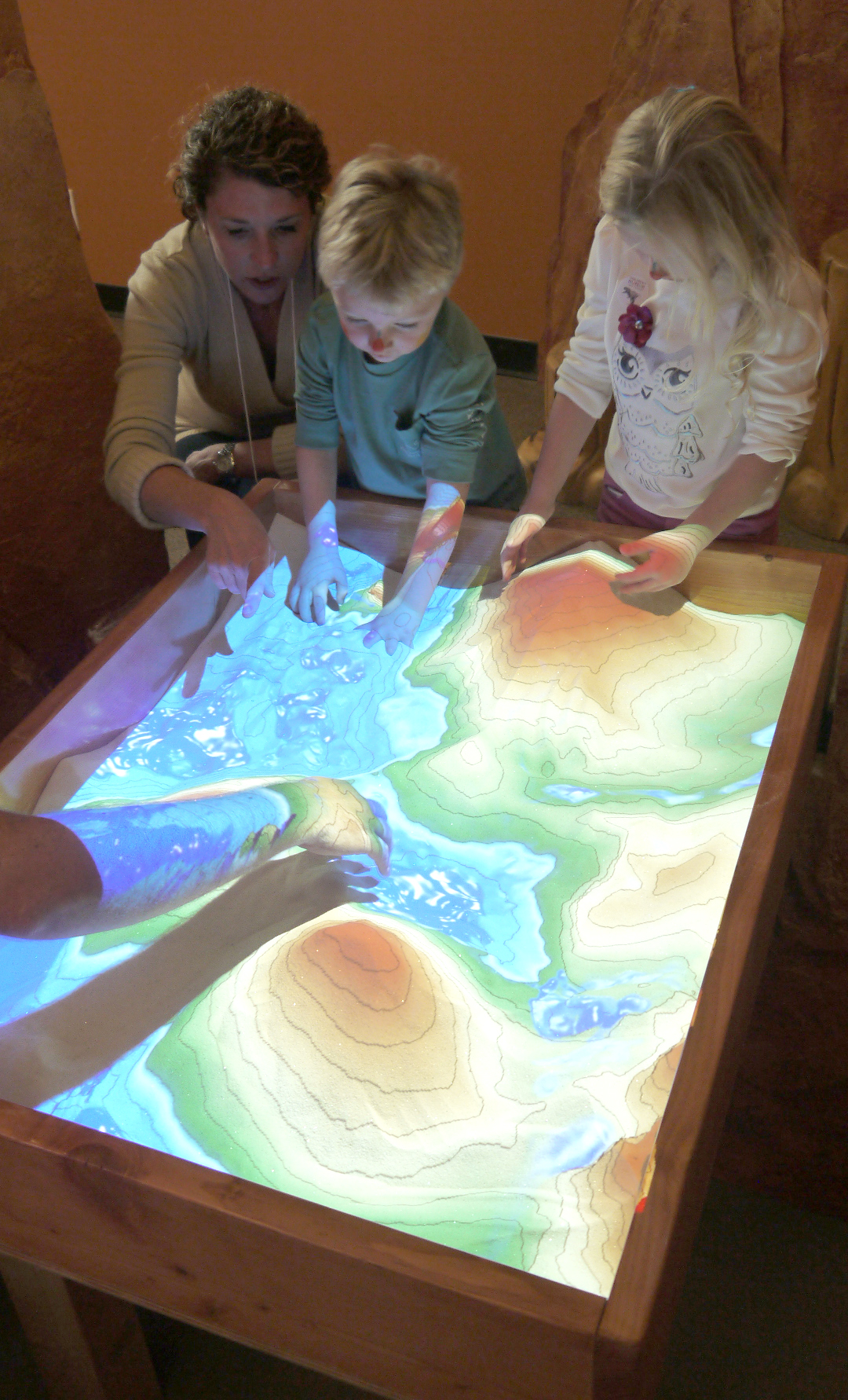 A new exhibit has opened at the Children’s Museum of New Hampshire and it combines all the fun of a sand table, with some interactive and responsive high tech imagery. Guests to the Museum can help shape the landscape with a new augmented reality sand table, installed in the ever-popular Dino Detective area.
A new exhibit has opened at the Children’s Museum of New Hampshire and it combines all the fun of a sand table, with some interactive and responsive high tech imagery. Guests to the Museum can help shape the landscape with a new augmented reality sand table, installed in the ever-popular Dino Detective area.
The technology behind this new exhibit was developed by the UC Davis W.M. Keck Center for Active Visualization in the Earth Sciences (keckCAVES), as part of an informal science education project funded by the National Science Foundation. This hands-on exhibit allows guests to create topography models by shaping real sand, which is then augmented in real time by an elevation color map, topographic contour lines and simulated water, rain and even snow. The system was created to teach geographic, geologic and hydrologic concepts, but the exhibit takes on a different significance when placed in the Museum’s Dino Detective area.
“The sand table relates to the Dino exhibit well,” says Exhibits Director Mark Cuddy. “Geology looks at changes to Earth’s landscape over time, which helps paleontologists determine where to find fossils and, sometimes more importantly, where NOT to look for fossils.” In the rest of the Dino Detective exhibit, guests can dig for fossils, donning the protective eye gear and using the specialized tools that paleontologists would use to unearth these remains. “This entire exhibit is about exploration and questioning what we think we know. Why are the dinosaurs extinct? What can we learn from their bones? How does the water flow around the sand? What happens when I build a dam and then break the dam? Where does the water go?” These kinds of questions are answered, not through labels on a wall, but by the constantly shifting interactivity between the augmented reality component, the sand and the children.
“The best part about this exhibit is that it appeals to everyone. Young, old, new or repeat visitors: Everyone loves to play with the sand!” says Mark. “I’ve heard some great things while watching guests at the table. Things like ‘Woah! Look I made it rain!’ or ‘Let’s all push the sand into a big mountain in the middle of a lake.’ It keeps our guests constantly engaged and learning.”
Early Learning Exhibits and Programs Take Center Stage
Children’s Museum of NH sponsors bring new life to popular programs and spaces

CEO of Wentworth-Douglass Hospital Greg Walker and Children’s Museum of New Hampshire President Jane Bard, along with some young guests, enjoy the newly spruced Primary Place of which Wentworth-Douglass Hospital is the sustaining sponsor.
Favorite fall programming for the younger set has begun at the Children’s Museum of NH. Wee Ones Wednesdays, which has a huge following with CMNH families, is now proudly sponsored by the Bank of New Hampshire. This drop-in class for walkers and talkers ages 2-4 is described by museum educators as “PRE-preschool.”
“This class is so popular that we offer two sessions, one right after the other in order to accommodate more kids,” says Education Coordinator Xanthi Gray. Beth Pagliuca, who has been bringing her children to Wee Ones since her daughter was a week old, said
“I loved Wee Ones as a first school style experience for my children. They learned to sing songs with their peers, do a craft and sit quietly eating a snack while listening to a story. All while still having the comfort of a parent or caretaker right there in the room with them. I think it helped prepare both my children for preschool because they both started preschool with big smiles and no concerns.”
After families take part in this or other Early Learning Programs such as Shake, Rattle and Read baby storytime or Junior Science Explorers, they can make their way to the second floor of the museum where the Primary Place, an Early Learning Landscape has gotten a major refresh from the exhibit’s Sustaining Sponsor, Wentworth-Douglass Hospital. This exhibit is designed specifically for the museum’s youngest visitors and the wear and tear on the beloved baby butterfly garden, animal puppets, giant box and train table are evidence of the over 700,000 kids that have enjoyed this space since 2008. “We are thrilled to support the exhibit,” says Dawn Fernald, Director of Marketing and Public Relations at Wentworth-Douglass Hospital.
“The Children’s Museum is a treasure in our community and provides wonderful experiences for families centering on education, history and culture with fun and interactive displays. The wow factor is huge!”
The Children’s Museum’s recent Toddlerfest celebration, which highlights all these programs, exhibits and more designed specifically for their youngest guests, culminated on Sunday, October 4 with Train Day from noon to 2pm. The trains, which are also featured in the second floor Primary Place, are a favorite exhibit and this program allows families to not only play in the museum, but also take a trolley to the Dover Rail Yard where they can climb on and explore a real locomotive.
"Of Beauty and Beasts" Illustrator Interviews
The illustrators from the summer 2015 Gallery 6 exhibition "Of Beauties and Beasts" answered some of our questions about their style of illustrating, from where they get their inspiration and more! The exhibit is on view in the Children's Museum of New Hampshire through Sunday, September 6.
Rebecca Emberley
Q. Your beasts from Ten Little Beasties are such great combinations of fangs and fur. Did the process of collage allow for some fun experimenting when creating these creatures?
A. Collage is a very forgiving art form and allows for lots of experimentation in any genre, but beasts are particularly fun! There are no limits to fangs, scales and horns!
 Karel Hayes
Karel Hayes
Q. In what way have your own favorite childhood books influenced you art today?
A. One of my favorite books from my childhood was a 1932 edition of Robert Lewis Stevenson's A Child's Garden of Verses. I found it in a second hand bookstore when I was about ten years old. Second hand bookstores were favorite places for my family to visit. I was first attracted to the book by the wonderful watercolors by Juanita C. Bennett. She was not as well-known as Jessie Wilcox Smith, but I think her work rivaled that well-know artist.
 Robert Squier
Robert Squier
Q. Your illustrations are done in “digital media” but the results look very traditional. What inspired your style of illustration?
A. I'd like to think my illustration style is still evolving! My earliest influences were Marvel comics and MAD magazine. When I started working professionally, I worked as a freelance commercial illustrator; that required me to be a chameleon, adapting my style to many different clients' needs.
When I made the transition to illustrating for children, I concentrated on traditional media like watercolor, acrylics and color pencil. I started working digitally out of necessity. Many of the projects I was working on required speed and flexibility – a digital illustration is easier to edit than an acrylic painting. My earliest digital work looked "computery," but over time I've learned to work in a manner that looks more traditional. I prefer a more traditional look because it allows me to bring in the texture, layers of color, and lively line that I developed during years of working in traditional media. But doing the work digitally allows me to work more quickly and allows for easier editing.
For most pieces, my process includes both digital and traditional techniques. For example, I might do a pencil sketch, scan it, tweak it on the computer, print it out, add shading and texture to the printout using an ink wash, scan it again, and then add color and additional texture on the computer.
 Emily Drouin
Emily Drouin
Q. Your art features some truly terrifying “Beasts.” Where do you get inspiration for these monsters?
A: Ever since I was a child, I've had a passion for illustration and storytelling, and love drawing monsters and robots! I am inspired by those countless trips to the library as a child, such books by Roald Dahl, Maurice Sendak, Chris Van Allsburg, Lewis Carroll, comics such as Calvin & Hobbes, Peanuts, Disney Adventures, and from Jim Henson movies and shows like Star Trek, Invader Zim, Futurama, Dr Who, Farscape and Stargate.
David McPhail
Q. Your two styles of illustrating, pen and ink and acrylics, are very different from each other. Do you find that one lends itself better to portraying “beauty” or “beasts”?
A. Nearly ALL of my books were done in pen and ink, and watercolor. A few are PENCIL and watercolor. Every few years, I feel the urge to "paint," to stand at an easel and apply gobs of paint to a canvas or board. Often, this desire to paint, coincides with a book illustration project that lends itself nicely to the medium. Edward and The Pirates, for example or Farm Boy's Year. When this "convergence" happens I get out my box of acrylics and I prepare some boards with a mix of white gesso, and Burnt Umber paint. I don't like to paint on a WHITE surface. It is much too stark for me. I prefer to paint on a mid-range tone, that way I can make SOME things darker and then bring the "lights" forward. When all is ready, I begin.
Unfortunately, a three or four year gap between "painting" projects, leaves me rusty, and unsure so it takes a while to get up to speed. Sometimes, by the time the book is finished, I feel that I'm just beginning to get the hang of it! But deadlines must be met! Of the nearly 200 books that I have illustrated, fewer than ten were done with "paint."
Yong Chen
Q. Most of your illustrations in the exhibit seem to focus on the “beauty” around us such as family, tradition, friends and even the underwater scene with the sinister looking shark is beautiful! Are there unexpected challenges when it comes to creating scenes of beauty?
A. Thank you for seeing my art in such perspective. Actually my goal of making art for children is to build connections of love, respect, curiosity and understanding between different cultures, and in large, between each individual person - us. I admit, I appreciate all the beauty around us, and perhaps that's why I naturally express how I see them in my paintings, but that is not the reason I make art. For example, the book Swimming with Sharks came to me when I didn’t understand much about sharks. After I read the manuscript, I upgraded my understanding of the universe, and how much we rely on the balance and health of the earth. I turned to passion to express my new ideal. Because I was afraid of sharks as I grew up, then I turned to respect the shark as an equal member of our living environment as a beautiful creature. When I worked on the illustrations for this project, I related these mixed feelings as I tried to communicate with my audience. If I just to create scenes of beauty, I may not have problems. But the trick is how to use beauty to educate my audience with messages so that they will accept, and that is not an easy task.
 Teri Weidner
Teri Weidner
Q. For people who have never tried to illustrate a children’s book, it might seem like a simple process. But your work goes through many edits and alterations before being finalized. Do you ever find that the process is tiring or is it all a challenge you’ve come to embrace?
A. I think illustrating a picture book is a sort of marathon. It can be a long, difficult process drawing 32 pages, but the format offers an amazing opportunity to tell a visual story. I start all my books knowing that the first round of sketches will probably change dramatically by the time I start the final color artwork. I really enjoy the process of reworking and refining the imagery. Most of my books go through at least 5 rounds of sketches, some initiated by me, some initiated by the editor and art director. My experience with publishers has varied dramatically from book to book. I've had some publishers that gave me almost no feedback beyond "This looks great!", even when I knew my drawings were still far from adequate. In those cases, I've continued to work on improving the sketches on my own, until I was also happy with the results. My favorite way to work, though, is with editors and art directors who can help me hone the imagery, and who offer up creative and clever ways to improve my sketches and make the book stronger. Occasionally I don't agree with their comments (which can be frustrating) but after a day or two of stewing I can usually begin to see where they're coming from and use their ideas as a spring board to improve the illustrations. Even with criticism I think is way off base can be helpful, because it forces me to define which direction the visual story is going, and defend my choices. If I can't defend them, then the pictures really do need to be reworked! So yes, sometimes the editing process can be tiring, but over the years it's something I've come to embrace. If it leads to a better book, it's worth all the effort!
Sean Bixby
Q. You have such a fun variety of creatures in your illustrations from The Uncrossable Canyon books. I imagine your sketchbook as being filled with drawing experiments. Is the planning/sketching phase the most fun for you or do you prefer working on the final illustration?
A. The planning and sketching phase are really fun to me. For The Uncrossable Canyon series, the author had many fantastic characters written into the story who were fun to design. There were also many other characters that I was able to create myself. There is a lot of brainstorming and experimenting in the process of coming up with characters. For crowd scenes I filled them with some of my favorite animals, including my dog, my favorite monsters and dinosaurs. I even looked at sketchbooks from when I was young and redesigned some of the characters I had created years ago. I have to focus a lot during this phase as I am constantly drawing and revising the characters and also the layout of the final illustration. It’s once I have the drawing down on the final paper that I can start to relax a bit more. When I start to paint, my mind is a little more free and I can listen to music, movies or podcast. So with all this said I would say have no preference as each part of the process is unique and challenging in its own way.
"Again!"
by Amanda Girard, Marketing Intern
We often hear that children, toddlers in particular, learn best through repetition. An article from Parents MagazineParents Magazine highlights that “while adults crave variety, a toddler needs repeated confirmation that things stay the same.” This may very well explain why your child delights in watching the same movie over and over again or asks for the same story every night at bedtime. And have you ever noticed how repetitive songs like “Old McDonald Had a Farm” and “B-I-N-G-O” are hits with young children? The early love of repetition explains it all.
So what may seem to us as boring or predictable is not only helping toddlers learn, it’s a lot of fun for them too. Knowing what’s going to happen next in the story or song is comforting.
So what does any of this have to do with the Children’s Museum? Many of our exhibits encourage this sort of repetitive learning. Pattern Palace gives kids an opportunity to discover different patterns and predict what colors and shapes come next. Our Pinscreen exhibit allows visitors to see imprints of their hands, faces, etc. over and over again.
Another important element of repetitive learning and the ways younger children learn is the need for variation. The same article from Parents Magazine uses the example that kids may start by simply banging a wooden block on a table and observing the sound it makes. Then, they may hit it harder and see what that does. They could also pick up a plastic hammer and hit the block that way to hear the difference. Though it may seem repetitive to us, to a child it is a new and exciting discovery.
CMNH supports this need for variation with our exhibits as well. The activities in our Muse Studio change every week to fit a new theme chosen by our museum educators. Build It, Fly It also promotes this kind of learning, where visitors can see how the way that they construct and launch different foam creations affects how their inventions fly. Kids get to tinker with their building methods to see what works best.
The Museum as a whole supports both repetitive and variation learning with its programs and exhibits. In general, kids and families can expect the museum to look similar to their last visit, with most of the same exhibits to interact with, providing a sense of comfort and memory for kids. But we work very hard to create an environment where they feel encouraged to explore and experiment in new ways.
So whether your child is in need of the comfort of repetition or the new world of variation, the Children’s Museum has something to offer everyone!
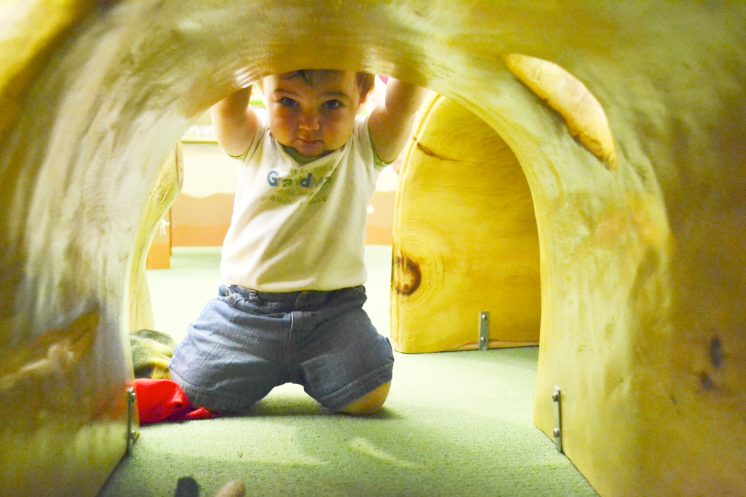
For Older Kids Too!
By Amanda Girard, Marketing Intern
Worried about bringing older kids to CMNH with their younger siblings? Afraid they might just stand there moaning, “I’m bored?” The Children’s Museum does offer exhibits and events that older kids can enjoy alongside their younger siblings so that the whole family can have some fun!
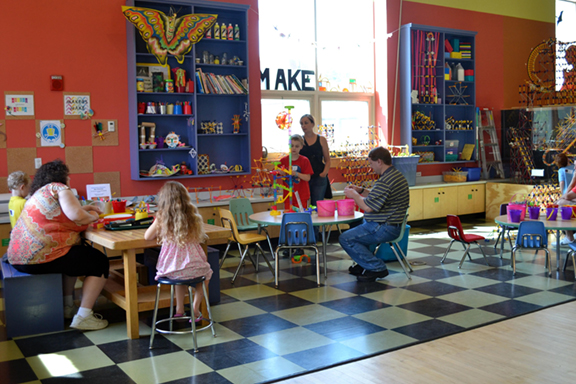
“The Muse Studio is a place that caters to all ages,” said Sarah Terry, one of the Museum’s educators. “We make a lot of the crafts open-ended, so you can make them as simple or as complex as you want.” Museum educators come up with new themes every week, like New England books or Super Heroes, and plan craft projects based around that theme.
 The Thinkering Lab is another exhibit that encourages guests to create anything they want, no matter how simple or how complex. Here you can build things with LEGOS, design vehicles and tracks, and create ball mazes.
The Thinkering Lab is another exhibit that encourages guests to create anything they want, no matter how simple or how complex. Here you can build things with LEGOS, design vehicles and tracks, and create ball mazes.
Finally, Mindball is a fun exhibit that many older kids and even adults enjoy! The game is simple: try to stay as relaxed as you can while an electronic headband monitors your brainwaves. See if you can beat your opponent and if you can stay more relaxed. (You could even switch up the game and see who can be the most un-relaxed!)
“A lot of our events are geared towards all ages too,” said Sarah Terry, “like Super Hero Week or our Mini Maker Faire.” If you’re an adult, you probably have great memories of discovering super heroes in comic books, and what better way to introduce your kids to those same super heroes than to take them to Super Hero Week here at the Children’s Museum. Maker Faire (coming up on August 29) is also an event that is for everyone. Some of our Makers this year are as young as 12 or 13 years old and older kids will get a chance to learn more about topics like robotics, engineering, music or art. Maker Faire has a lot to offer everyone.
So, if you are looking to bring the whole family (including older kids) to the Museum, a special program or some of our tried and true exhibits may be a good opportunity to get everyone engaged and involved!
Ascent or Descent
A Public Art Collaboration
Have you been by the Children’s Museum of New Hampshire recently? There seems to be a group of characters climbing . . . sitting . . . jumping . . . flying? Are they climbing up . . . sideways . . . down? Are they friendly or not so nice? Where did they come from and what are they doing on the front of CMNH?
Ascent or Descent is a collaborative public art project designed by the Children’s Museum of New Hampshire with six Seacoast area artists and craftspeople. This project is designed to make you curious and wonder what it is, exactly, that's happening with these figures upon our facade and what the different stories may be behind each one. We purposefully kept our description of a 'humanoid sculpture' request very broad when potential contributors were contacted. We wanted to show a diverse group of 'people' created in a variety of styles using a multitude of materials.
David Masse is a local blacksmith living on the southeastern coast of Maine who used this opportunity to design and construct something different than he would typically.
Masse decided to create a superhero and shaped it by using forged steel. He then added a fabric cape that blows in the wind. What do you think this superhero's codename is? What are his powers and how did he get them? What if he (or she!) isn't a hero . . . but a villain?!
You can check out more of David Masse's work on his website.
Rick Burns, a sculptor working based in Berwick, ME, describes his work as "creating Industrial Symbolic Abstractions using metal, wood, clay and mixed media".
If you look closely at his sculpture, you can discover some hidden objects! Do you see the wrenches that make up the arms between the elbow and the wrist?
What about the gears inside the chest? Do the gears help this character move? Does he have to be wound up like a toy? And, of course, you can't possibly miss the incredibly cool medieval helmet with pieces of chain mail. This "humanoid sculpture" is ready for anything!
You can find more creative works of art from Rick Burns at his website.
Adam Pearson is a New Hampshire based sculptor and craftsman. His child-sized figure is jumping . . . or is he flying . . . off the roof of the Children's Museum! Is this the first time he's opened up his wings and flown? Is he looking for food . . . or is he playing a game? Is he headed towards the park . . . or higher into the trees?
This sculpture, the highest piece in the installation, was created by Pearson cutting, bending and welding the metal and steel of the green body and the large red tail and swooping wingspan.
More of Adam Pearson's work can be found on his website.
Chris Wright is a local artist and Director at the Port City Makerspace. For Ascent or Descent, Wright designed and created a piece that is fashioned almost entirely from aluminum. This includes the frame, bones, ribs, head, and extremities!
Wright fabricated every piece of the sculpture, including all the individual vertebrae in the articulated spine.
There was a time not too long ago that Nate Walker's Giant Blue Crab sculpture was one of the only pieces of public art in the city of Dover. Now, Wright's piece joins five other pieces of public art looking down at art in several places in Henry Law Park!
Like Chris Wright, Jeff Gunn is also a Director at the Port City Makerspace and a local craftsman. Gunn began with aluminum to create the general form of the body for this robot . . . or is it astronaut . . . or is it robot astronaut?
He then heated and bent PVC boards to create the white outer shell around the aluminum. To design and produce the hands and other smaller parts for this piece, Gunn used some newer technology: a 3D printer!
One of the coolest features of this piece is one that can't be seen from the ground - but its effect can! On the top of right shoulder, Gunn installed a solar panel. The panel is connected to the "eye" bulb of the robot figure. So after a long day of bright sunshine, a cyclopean beam of light emerges as dusk falls. Is he guarding the museum . . . or is he guarding the park? Is he taking a picture with his eye . . . or shooting lasers?
Kali Ann Rocheleau is an artist who enjoys exploring many different mediums, including charcoal, watercolor, sculpture, and cartooning. She lives in Portsmouth with her fiancée and loves to create art whenever she can.
Rocheleau chose to make sculpture with a more whimsical, pencil-sketch like quality. She created this sculpture using bent and twisted pieces wire. One of the coolest part's of this central piece of the installation is that depending on where you're viewing it from, it seems to change shape. From one angle it appears to be a woman, but from another - a man. From the outside you can see its hands and fingers in great detail, while the feet and toes are better viewed from inside. This piece also blends in with the building almost perfectly. Is it because the figure has the ability to turn invisible? Is she made up of water . . . or is it air?
More of Kali Ann Rocheleau's art can be found on her Facebook page.
The amazing . . . or is it magical . . . or is it scientific . . . or is it fantastical figures that make up Ascent or Descent will be visiting the museum and Henry Law Park from June to the end of October 2015. For those interested in previous public art projects by the Children's Museum of New Hampshire, check out our look at Bryan Rutland's abstract art piece that adorned our building through this last winter and spring or at the journey of how artist Nate Walker and the Dover Middle School Art Club designed, created and installed the Octopus Bike Rack in front of CMNH.


